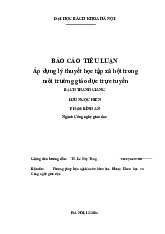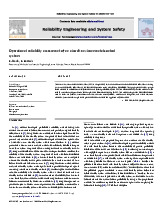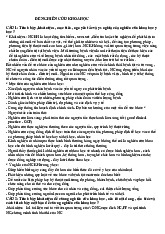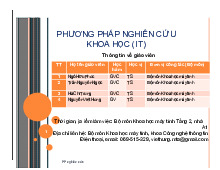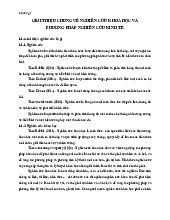




Preview text:
Nghiên cứu chế tạo nano sắt từ dịch chiết thực vật ứng dụng kích thích nảy mầm ở hạt ngô
Nguyễn Hoài Phương1,*, Nguyễn Thùy Linh1, Nguyễn Phúc Tô Châu1, Nguyễn Lan Anh1,
Trịnh Quang Đạt1
1Trường Hóa và Khoa học sự sống, Đại học Bách Khoa Hà Nội, số 1 Đại Cồ Việt, Hà Nội
* Email: phuong.nh201692@sis.hust.edu.vn Abstract
Nano sắt ngày nay được ứng dụng phổ biến để hỗ trợ cho ngành nông nghiệp, nhờ đặc tính nổi bật như kích
thước siêu nhỏ, khả năng phản ứng cao và thân thiện với môi trường. Sử dụng phương pháp tổng hợp xanh
nhằm mục đích giảm thiểu hóa chất khi điều chế hạt nano sắt và quy trình tổng hợp không hề phức tạp. Khảo
sát dịch chiết thực vật phù hợp để tổng hợp nano sắt là lá bàng với hàm lượng polyphenol là 85,12 (mgGAE/g
chất khô) và hàm lượng flavonoid là 103,267 (mgQE/g chất khô). Tổng hợp thành công vật liệu nano sắt từ dịch
chiết lá bàng, đánh giá hình thái cấu trúc vật liệu bằng phương pháp hiện đại như SEM, XRD, và FTIR thu được
vật liệu nano sắt có hình cầu và đường kính trung bình từ 20-200nm. Nghiên cứu các điều kiện tổng hợp nano
sắt ảnh hưởng đến kích thích nảy mầm trên hạt ngô, với nồng độ FeCl3 0,0075M, nhiệt độ tổng hợp là 60˚C và
thời gian tổng hợp là 30 phút cho kết quả tỷ lệ nảy mầm cao nhất và chỉ số sức sống của hạt cao nhất. Hạt ngô
ngâm trong dung dịch nano sắt ở các nồng độ pha loãng từ 4 lần đến 6 lần sẽ cho tỷ lệ nảy mầm và chỉ số sức
sống cao, các hạt phát triển đồng đều.
Keywords: Nano sắt; Tổng hợp xanh; Kích thích nảy mầm trên hạt ngô. 1. Introduction1
3) Courtesy authorship is discouraged; only relevant prior work should be cited.
This template contains instructions for preparing the
manuscript to be submitted to the Student Scientific
1.2. Publication Principles Research Conference (SVNCKH).
Authors should consider the following points:
1) The submitted work should be original and should
1) Papers should advance knowledge and cite
not have been presented at any previous relevant prior work.
SVNCKH conferences organized by HUST or elsewhere.
2) Paper length should match the significance and
complexity of the work; minor extensions of prior
2) The research should represent a genuine research may not be suitable.
collaborative effort among the listed authors, with
no disputes regarding authorship, copyright, or
3) Authors should demonstrate scientific and any related interests.
technical merit, with higher proof standards for extraordinary findings.
3) Each author's contribution and affiliation must be
clearly stated, with one designated corresponding
4) Papers should provide sufficient details for author.
replication while including new and fully described information.
4) Research project results require permission from
funding agencies and proper acknowledgment.
1.3. Copyright Form
1.1. Publishing Policy
Upon submission, authors might complete the
'Copyright Transfer Form', granting SVNCKH global
The SVNCKH policy mandates that submissions
rights to use the paper and waiving any privacyrelated should be original.
claims. Redistribution, resale, or derivative works
1) Authors must disclose all prior publications and
require publisher permission. Authors must obtain
current submissions. Preliminary data or results
consent and credit sources for any copyrighted content should not be published.
used. 1.4. General Format Guidelines
2) The corresponding author must secure agreement
Manuscripts must follow the journal’s A4
from all co-authors and any necessary consent
template and be submitted in Word and PDF via the
from employers or sponsors before submission.
online system. Images should be properly sized to avoid large files. 1 SVNCKH 2024 - 2025
Papers use a two-column A4 format with 0.7 cm
column spacing. Page size is A4, portrait. Margins:
Top 3 cm, Bottom 2.5 cm, Left/Right 2.5 cm,
Header/Footer 1.27 cm. Text is in Times New Paragraphs have 6 pt spacing after and a 0.75 cm Roman, size 10,
justified. The abstract is in Arial. first-line indent.
Table 1. Font and paragraph format – an example of a single-column format for a large table or figure. Item Font Font size Paper Title Times New Roman Author Times New Roman Affiliation Times New Roman Abstract Arial 9 Keywords Arial 9 Heading 1 Times New Roman Heading 1.2 Times New Roman Heading 1.3 Times New Roman Text Times New Roman Figure caption Times New Roman Table caption Times New Roman Reference Times New Roman 9 14pt 12pt 10pt pt pt 10pt 10pt 10pt 10pt 10pt 10pt pt
Titles follow sentence case, avoiding parentheses,
Numbered or bulleted lists should be used only
special symbols, or long formulas. Full author names
when necessary, ensuring parallel structure and similar
and affiliations are preferred, with spaces between line lengths.
initials. Each author’s contribution must be clarified,
2. Guidelines for Manuscript Preparation
and one corresponding author designated with details matching the SVNCKH system.
2.1. Abbreviations and Acronyms
Sections and sub-sections are limited to three
Define abbreviations and acronyms the first time
levels. Tables, figures, equations, and technical terms
they are used in the text, even after they have already
such as algorithms and theorems must be numbered
been defined in the abstract. Abbreviations that
sequentially and properly cited. Poor formatting may
incorporate periods should not have spaces: write lead to rejection.
“C.N.R.S”, not “C. N. R. S”. Do not use abbreviations
in the title unless they are unavoidable.
2.2. Other Recommendations
to papers in data storage. For example, write “15 Gb/cm2 (100 Gb/in2).”
Use one space after periods and colons.
Hyphenate complex modifiers: “zero-field-cooled
An exception is when English units are used as
magnetization”. Avoid dangling participles, such as,
identifiers in trade, such as “3½-in disk drive”. Authors
“Using (1), the potential was calculated”. It is not clear
should clearly state the units for each quantity in an
who or what used (1). Write instead, “The potential
equation. Avoid combining SI and CGS units.
was calculated by using (1),” or “Using (1), we calculated the potential”.
4. Some Common Mistakes
Use a zero before decimal points: “0.25”, not
The word “data” is plural. The subscript in 𝜇0 is
“.25”. Use “cm3”, not “cc”. Indicate sample
zero, not “o.” Use “remanence” (noun) and “remanent”
dimensions as “0.1 cm × 0.2 cm”, not “0.1 × 0.2 cm2”.
(adjective), not “remnance15” or “remnant.” Write
The abbreviation for “seconds” is “s”, not “sec”. Use
“micrometre” instead of “micron.” A graph within a
“Wb/m2” or “webers per square meter”, not
graph is an “inset,” not an “insert.” Prefer
“webers/m2”. When expressing a range of values, write
“alternatively” to “alternately” (unless referring to
“7 to 9” or “7 - 9”, not “7 ∼ 9”.
simultaneous events) and “whereas” to “while” (unless
referring to simultaneous events). Avoid using
A parenthetical statement at the end of a sentence
“essentially” for “approximately” or “effectively,” and
is punctuated outside of the closing parenthesis (like
“issue” as a substitute for “problem.”
this). Periods and commas are outside quotation marks,
like “this period”. Avoid contractions; for example,
For unspecified compositions, use en-dashes:
write “do not” instead of “don’t”. The serial comma is
“Ni–Mn” indicates an alloy, while “NiMn” refers to
preferred: “A, B, and C” instead of “A, B and C”.
Ni0.5Mn0.5. Differentiate between homophones:
“affect” (verb) vs. “effect” (noun), “complement” vs. 3. Math
“compliment,” “discreet” vs. “discrete,” “principal”
If you are using Word, use either the Microsoft
(e.g., “principal investigator”) vs. “principle” (e.g., Equation Editor or the MathType add-on
“principle of measurement”), and “imply” vs. “infer.”
(http://www.mathtype.com) for equations in your
Prefixes like “non,” “sub,” “micro,” “multi,” and
paper. Equations should be placed in line with the text.
“ultra” are not separate words and should be joined 3.1. Equations
without hyphens. The Latin abbreviation “et al.” has no
period after “et.” Use “i.e.,” for “that is” and “e.g.,” for
Number equations consecutively with equation
“for example” (not italicized).
numbers in parentheses and align these equation
numbers in the right. To make your equations more
5. Graphics Preparation
compact, you may use the solidus (/), the exp function,
5.1. Types of Graphics
or appropriate exponents. Italicize Roman symbols for
quantities and variables, but not Greek symbols. Use a
The The following list outlines the different types
long dash rather than a hyphen for a minus sign.
of graphics published in SVNCKH. They are
Punctuate equations with commas or periods when
categorized based on their construction, and use of
they are part of a sentence, as in:
shades of gray: 5.1.1. Grayscale figures
Figures that are meant to appear in shades of ⃗E
black/gray. Such figures may include photographs, ρ=
illustrations, graphs, and flowcharts. m J
5.1.2. Line Art figures C (T=const.)⋅
Figures that are composed of only black lines and
shapes. These figures should have no shades or half- (1)
tones of grey, only black and white.
Be sure that the symbols in your equation have been 5.1.3. Tables
defined before or immediately following the equation.
Use “(1)”, not “Eq. (1)” or “equation (1)”, except at
Data charts are typically black and white.
the beginning of a sentence: “Equation (1) is . . .”.
5.2. Multipart Figures 3.2. Units
Figures compiled of more than one subfigure
Use either SI (MKS) or CGS as primary units. (SI
presented side-by-side or stacked. If a multipart figure
units are strongly encouraged.) English units may be
is made up of multiple figure types (one part is line art,
used as secondary units (in parentheses). This applies
and another is grayscale) the figure should meet the
not just “M”. Put units in parentheses. Do not label
stricter guidelines. 5.3. File Formats for Graphics axes only with units. As in
Fig.1, for example, write “Magnetization (A/m)” or
Format and save graphics using a suitable
program that supports PostScript (PS), Encapsulated
“Magnetization (A ¿ m 1)”, not just “A/m”. Do not label
PostScript (EPS), Tagged Image File Format (TIFF),
axes with a ratio of quantities and units. For example,
Portable Document Format (PDF), or Portable
write “Temperature (K)”, not
Network Graphics (PNG). Ensure proper sizing and “Temperature/K”.
resolution adjustments. If created in Microsoft Word,
Table 2. An example of a table
PowerPoint, or Excel, conversion to PS, EPS, TIFF, Column heading Column A Column B
PDF, or PNG is not required. However, saving in PDF (t) (T)
format is strongly recommended over DOC, XLS, or
PPT to avoid font and arrow stroke inconsistencies And an entry 1 2 across platforms. And another entry 3 4
5.4. Sizing of Graphics And another entry 5 6
Most charts, graphs, and tables are one column
wide (3.5 inches/88 millimetres/21 picas) or page wide And another entry 0 0
(7.16 inches/181 millimetres/43 picas). The maximum
Multipliers can be especially confusing. Write
depth a graphic can be is 8.5 inches (216 “Magnetization (kA/m)” or “Magnetization
millimetres/54 picas). When choosing the depth of a
(103A/m)”. Do not write “Magnetization (A/m)
graphic, please allow space for a caption. Figures can
1000” because the reader would not know whether the
be sized between column and page widths if the author
top axis label in Fig.1 meant 16000 A/m or 0.016 A/m.
chooses, however it is recommended that figures are
Figure labels should be legible, approximately 8
not sized less than column width unless when
to 10 points type, font type Times New Roman or Arial. necessary.
Note that “Fig.” is abbreviated. There is a period 5.5. Resolution
after the figure number. It is good practice to explain
The proper resolution of your figures will depend
the significance of the figure in the caption.
on the type of figure it is as defined in the “Types of
Figures” section. Author photographs, colour, and
grayscale figures should be at least 300 dpi. Line art,
including tables should be a minimum of 600 dpi. 5.6. Vector Art
To preserve the integrity of the figures across
multiple computer platforms, we accept files in the
following formats: .EPS/.PDF/.PS. All fonts must be
embedded or text converted to outlines to achieve the best quality results.
5.7. Figures and Tables
Large tables and figures may span both columns.
Table 1 shows a single-column format, while Table 2
follows the common format. Captions should be one
Fig. 1. Magnetization as a function of applied field.
line, justified. Figure captions go below figures, table
5.7.2. Subfigure Labels in Multipart Figures and
titles go above tables. Label multi-part figures as “(a)” Tables
and “(b)” within the artwork. Ensure mentioned figures
and tables exist. Do not include captions inside figures,
Multipart figures should be combined and
use text boxes, or add borders. Use “Fig.” even at
labelled before final submission. Labels should appear
sentence start, but do not abbreviate “Table.” Tables
centered below each subfigure in 8 points Times New
are numbered with Roman numerals.
Roman font in the format of (a) (b) (c).
5.7.1. Figure Axis labels 6. Conclusion
Figure axis labels are often a source of confusion.
Although a conclusion may review the main
Use words rather than symbols. As an example, write
points of the paper, do not replicate the abstract as the
the quantity “Magnetization”, or “Magnetization M”,
conclusion. Consider elaborating on the translational
importance of the work or suggest applications and
extensions. Authors are requested to highlight the
contribution of the research presented in this
partapplications and extensions. Authors are requested
to highlight the contribution of the research presented in this part. Acknowledgments
Use the singular heading even if you have many
acknowledgments. Avoid expressions such as “One of
us (S.B.A.) would like to thank ...” Instead, write “F. A. Author thanks ...”
It will also contain support information,
including sponsor and financial support
acknowledgment. For example, “This work was
supported by the …. under the Grant T2020-PC000”. References
Reference style should be strictly followed by the
guidance in the examples below. It is recommended to
keep the total number of references between 10-12
documents. References should be numbered in
sequence and cited in the main text.
Citations should appear on the line, in square
brackets, inside the punctuation, e.g., [1]. Multiple
references should be cited as [1–3]. Avoid automatic
endnotes; instead, list references manually at the end of the paper.
Reference numbers should be flush left in square
brackets. Author names are abbreviated to initials
before the last name. Use “et al.” only if no full names
are given. Abbreviate conference titles and include
relevant details for patents. If a URL is included, a DOI is recommended.
Capitalize only the first word in paper titles,
except for proper nouns and element symbols. For
translated papers, list the English citation first,
followed by the original language citation.
[1] J. K. Author, Title of His Published Book, in Title of His
Published Book, n ed., Abbrev. of Publisher, 1970, ch. x, sec. x, xxx–xxx pp.
[2] J. K. Author, Name of paper, Abbrev. title of periodical,
vol. 11, no. 2, pp. 123–456, Jan. 2024.
https://doi.org/10.1109.XXX.123456.
[3] J. K. Author, Title of report, Name of Co., City of Co., Abbrev. State, Country 2024.
